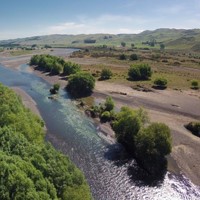
Current filter:

Water quality monitoring by Hawke’s Bay Regional Council staff indicates that potentially toxic algae levels are present on the Tukituki River, at Black Bridge near Haumoana.
Parts of the Tukituki River are prone to algal growth in summer, due to lower water flows, higher water temperatures and nutrients in the water. Green strand algae is harmless but black Phormidium bacteria growth on the rocks is potentially toxic for humans and dogs. It can detach from the rocks and dry as mats on the sides of the rivers, and these can also be toxic.
“Our advice is to always treat the black growth on rocks in the water and the drying mats as toxic, stay out of the water if you see it, and swim or walk your dog elsewhere,” says HBRC’s Senior Environmental Scientist Anna Madarasz-Smith.
She adds that science has not yet identified when Phormidium turns toxic or why, so to be safe it should always be treated as harmful.
People can check water quality and algae warnings here which displays data from LAWA (Land Air Water Aotearoa = www.lawa.org.nz).
Warning signs would be put up at affected areas by HB District Health Board staff, but people were urged to avoid contact with the cyanobacteria mats and to keep animals away.
For information:
https://www.lawa.org.nz/explore-data/hawkes-bay-region/river-quality/tukituki-river/tukituki-river-at-black-bridge-(haumoana)/
What are Cyanobacteria?
Cyanobacteria are single celled creatures that live in water environments. Cyanobacteria have characteristics in common with both bacteria and algae. In warm nutrient rich conditions free-floating cyanobacteria cells can multiply quickly to form what are known as algal blooms. Large numbers of Cyanobacteria can also grow as mats on river and lake beds and these mats can sometimes detach and float to the surface. Some cyanobacteria species produce toxins (cyanotoxins), which pose a risk to humans and animals when consumed in drinking water or by direct contact during recreational activities.
29 March 2018
Disclaimers and Copyright
While every endeavour has been taken by the Hawke's Bay Regional Council to ensure that the information on this website is
accurate and up to date, Hawke's Bay Regional Council shall not be liable for any loss suffered through the use, directly or indirectly, of information on this website. Information contained has been assembled in good faith.
Some of the information available in this site is from the New Zealand Public domain and supplied by relevant
government agencies. Hawke's Bay Regional Council cannot accept any liability for its accuracy or content.
Portions of the information and material on this site, including data, pages, documents, online
graphics and images are protected by copyright, unless specifically notified to the contrary. Externally sourced
information or material is copyright to the respective provider.
© Hawke's Bay Regional Council - www.hbrc.govt.nz / +64 6 835 9200 / info@hbrc.govt.nz